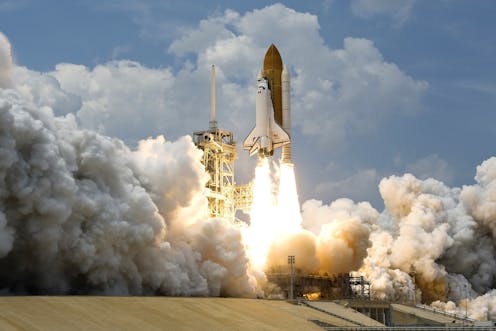Fique off-line com o app Player FM !
What’s the next ‘giant leap’ for humankind in space? We asked 3 space experts
Manage episode 238351085 series 1575188

You’ve probably heard that this week marks 50 years since humans first set foot on the Moon – a feat that still boggles the mind given the limitations of technology at the time and the global effort required to pull it off.
If you’re as fascinated as we are about the history and future of space exploration, check out The Conversation podcast, To the moon and beyond, a five-part podcast series from The Conversation. We’ve featured a little taste of it on Trust Me today.
Through interviews with academic experts around the world – from space scientists to historians, lawyers, futurists and a former astronaut – science journalist Miriam Frankel and space scientist Martin Archer look at the past 50 years of space exploration and what the 50 years ahead have in store.
Episode two features Australia’s own space archaeologist, Alice Gorman, in conversation with Sarah Keenihan about why Apollo 11 landing spots could become heritage sites for future generations of visitors to the Moon.
But today, The Conversation’s Molly Glassey sits down with a panel of astrophysicists to ask the big questions about space, like: what’s the next big thing that’s happening in space research, the thing that will blow us away or bring us together the way the Moon landing did back in 1969? And what’s the likelihood we’ll be living on Mars or the Moon in future?
Today, Molly chats to astrophysicists Jonti Horner and Belinda Nicholson from the University of Southern Queensland and planetary scientist Katarina Miljkovic from Curtin University.
You can find all the episodes of To the moon and beyond on your podcast app, or on our site here.
New to podcasts?
Podcasts are often best enjoyed using a podcast app. All iPhones come with the Apple Podcasts app already installed, or you may want to listen and subscribe on another app such as Pocket Casts (click here to listen to Trust Me, I’m An Expert on Pocket Casts).
You can also hear us on Stitcher, Spotify or any of the apps below. Just pick a service from one of those listed below and click on the icon to find Trust Me, I’m An Expert.
Credits:
To the moon and beyond is produced by Gemma Ware and Annabel Bligh. Sound editing by Siva Thangarajah. Thank you to City, University of London’s Department of Journalism for allowing use of their studios for To the moon and beyond, and to .
Music: Even when we fall by Philipp Weigl, via Free Music Archive
Fallen Stars by Ketsa, via Free Music Archive
Apollo 11 and 17 audio from NASA
Additional audio
Kindergarten by Unkle Ho, from Elefant Traks.
Images
Pixabay/WikiImages
52 episódios
Manage episode 238351085 series 1575188

You’ve probably heard that this week marks 50 years since humans first set foot on the Moon – a feat that still boggles the mind given the limitations of technology at the time and the global effort required to pull it off.
If you’re as fascinated as we are about the history and future of space exploration, check out The Conversation podcast, To the moon and beyond, a five-part podcast series from The Conversation. We’ve featured a little taste of it on Trust Me today.
Through interviews with academic experts around the world – from space scientists to historians, lawyers, futurists and a former astronaut – science journalist Miriam Frankel and space scientist Martin Archer look at the past 50 years of space exploration and what the 50 years ahead have in store.
Episode two features Australia’s own space archaeologist, Alice Gorman, in conversation with Sarah Keenihan about why Apollo 11 landing spots could become heritage sites for future generations of visitors to the Moon.
But today, The Conversation’s Molly Glassey sits down with a panel of astrophysicists to ask the big questions about space, like: what’s the next big thing that’s happening in space research, the thing that will blow us away or bring us together the way the Moon landing did back in 1969? And what’s the likelihood we’ll be living on Mars or the Moon in future?
Today, Molly chats to astrophysicists Jonti Horner and Belinda Nicholson from the University of Southern Queensland and planetary scientist Katarina Miljkovic from Curtin University.
You can find all the episodes of To the moon and beyond on your podcast app, or on our site here.
New to podcasts?
Podcasts are often best enjoyed using a podcast app. All iPhones come with the Apple Podcasts app already installed, or you may want to listen and subscribe on another app such as Pocket Casts (click here to listen to Trust Me, I’m An Expert on Pocket Casts).
You can also hear us on Stitcher, Spotify or any of the apps below. Just pick a service from one of those listed below and click on the icon to find Trust Me, I’m An Expert.
Credits:
To the moon and beyond is produced by Gemma Ware and Annabel Bligh. Sound editing by Siva Thangarajah. Thank you to City, University of London’s Department of Journalism for allowing use of their studios for To the moon and beyond, and to .
Music: Even when we fall by Philipp Weigl, via Free Music Archive
Fallen Stars by Ketsa, via Free Music Archive
Apollo 11 and 17 audio from NASA
Additional audio
Kindergarten by Unkle Ho, from Elefant Traks.
Images
Pixabay/WikiImages
52 episódios
Todos os episódios
×Bem vindo ao Player FM!
O Player FM procura na web por podcasts de alta qualidade para você curtir agora mesmo. É o melhor app de podcast e funciona no Android, iPhone e web. Inscreva-se para sincronizar as assinaturas entre os dispositivos.










